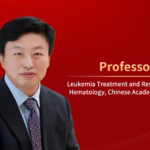Editor's Note
Welcoming a new chapter in hematology, the Fourth China Hematology Development Conference (CASH), organized by the Peking Union Medical College of the Chinese Academy of Medical Sciences and hosted by the Institute of Hematology & Blood Diseases Hospital of the Chinese Academy of Medical Sciences, was grandly held in Tianjin from January 5th to 7th. Continuing with the theme of "Broad Hematology, Comprehensive Healthcare, and General Well-being," this conference invited over 400 domestic and international experts, leading scholars, and healthcare industry managers in hematology and related fields. It focused on the core developmental directions of hematology in China, exploring the forefront of innovative knowledge in the pulse of innovation, and seeking the heights of innovation in the light of science and technology. Concurrently, significant information in the field of hematology for the year 2023 was released. At the conference, "Oncology Watch - Hematology Newsletter" had the honor of interviewing Professor JianXiang Wang , the perennial chairman of the China Hematology Development Conference and the chief clinical expert at the Institute of Hematology & Blood Diseases Hospital of the Chinese Academy of Medical Sciences. Professor Wang provided in-depth insights and commentary on topics like the development of hematology in China, domestic innovative drugs, updates on guidelines, and the construction of quality control centers.
Advancing the Discipline for Healthy Development
“Oncology Frontier – Hematology Frontier“: With the Fourth China Hematology Development Conference (CASH) about to commence, as the perennial chairman of CASH, could you talk about the progress made in the field of hematology in China in recent years? What role has CASH played in promoting the development of hematology in China?
Professor JianXiang Wang : As a conference dedicated to the development of the discipline, the main aim of CASH is to organize and forecast the current situation and future prospects of hematology in China, and to plan how to promote healthy development and talent cultivation in this field. Over the years, the conference has significantly propelled the healthy development of the discipline, including major research advancements; emergence of potential research outcomes; and discussions and organization of major scientific issues in research directions and areas. Since these conferences began, several important hematology research programs in China have been initiated, encompassing basic research, clinical research, and the development of cutting-edge technologies. By holding these conferences, there has been a substantial promotion of research and development in hematology and frontier technologies. Therefore, it can be said that the development of hematology in China in recent years is inseparable from the positive impact of these conferences.
Domestic Innovative Drugs, Meeting Unmet Needs
“Oncology Frontier – Hematology Frontier“: As the first domestically developed original research CD19 CAR-T drug, Najiakelunsa injection was recently approved for marketing, marking a breakthrough in CAR-T treatment for leukemia in China. How do you view the value of this innovative domestic drug?
Professor JianXiang Wang : There are several CAR-T therapies, and previously, the two CD19 CAR-T drugs available in our country were from foreign pharmaceutical companies, used in the field of non-Hodgkin’s lymphoma. In earlier years, to address the challenges of treating blood cancers in China, we focused on immunotherapy. Leveraging our institute’s research foundation and advantages in monoclonal antibodies, we developed a CD19 CAR-T drug with independent intellectual property rights in China, aimed at treating adult Acute Lymphoblastic Leukemia (ALL), as there were no effective drugs for adult ALL at that time. Following the achievement of endpoints in early clinical studies, this drug was approved for treating adult relapsed/refractory ALL. Since there were no good drugs for this group of patients, the National Medical Products Administration also certified it as a “breakthrough therapy.” As a new drug, Najiakelunsa injection not only addresses the treatment challenges for adult relapsed/refractory ALL patients in China but also provides insights into the development of innovative drugs. It emphasizes the need for foundational research, identifying appropriate indications, and addressing unmet needs. Moreover, as an innovative drug with independent intellectual property rights in China, it also demonstrates our capability to solve the challenges of blood diseases in China with our own research.
Guideline Consensus Updates, Changing Clinical Diagnosis and Treatment Practice – Hematology Newsletter
“Oncology Frontier – Hematology Frontier“: During the “Leukemia” thematic forum, you interpreted the European Leukemia Network (ELN)/AML International Consensus Classification (ICC) guidelines. Could you share the key updates in the diagnosis and risk stratification of AML, standards of efficacy, and treatment recommendations?
Professor JianXiang Wang : With continuous deepening in the understanding and research of leukemia, new discoveries in the diagnosis and treatment of leukemia may impact clinical practice. How can these research advancements be communicated to the industry? Through guideline consensus, these pieces of information can be conveyed, thereby changing the industry’s understanding and practice in disease diagnosis and treatment. In recent years, several important international guidelines and consensus, including the World Health Organization (WHO) guidelines, European Leukemia Network (ELN) guidelines, and International Consensus Classification (ICC), have been updated. Specifically, there are new molecular classifications for AML. These molecular classifications influence the prognosis, and hence, the guideline consensus reflects changes in AML molecular classification and prognosis, including the addition of many new high-risk molecular subtypes. Moreover, based on these diagnostic classifications, a series of new drugs for treating leukemia have emerged. The guideline consensus also reflects the application of these new drugs in AML, including how to use them in elderly patients, in frontline adult treatment, and in relapsed patients, mainly focusing on the combined use of targeted drugs. In terms of treatment monitoring, the guideline consensus pays more attention to the quality of remission, focusing on the level of minimal residual disease (MRD) burden. Monitoring to achieve MRD-negative complete remission will impact treatment outcomes. Overall, the guideline consensus updates the diagnostic classification, prognosis judgment, MRD monitoring, and overall treatment selection principles for AML, with detailed content that requires careful digestion and absorption.
Leading the Construction of Quality Control Centers
“Oncology Frontier – Hematology Frontier“: Recently, the Blood Disease Hospital of the Chinese Academy of Medical Sciences was approved to lead the establishment of the National Hematology Internal Medicine Quality Control Center. You also shared related work at this conference. Could you discuss the challenges in setting up the National Hematology Internal Medicine Quality Control Center and how to resolve them?
Professor JianXiang Wang : The work of the quality control center mainly involves organizing the processes and indicators during treatment, which can affect treatment outcomes, also known as quality control indicators. Identifying these important indicators is crucial for quality control work. Therefore, the first challenge is how to extract quality control indicators from a multitude of data. The second challenge is how to further improve after identifying the quality control indicators. We even issue directives to various hospitals to reorganize and collect data for improvement, but how to effectively and timely collect data from numerous hospitals is also a problem. Given the busy nature of clinical work and various limitations, whether everyone has the time and energy to cooperate, extract, and report data is crucial. The third challenge is how to propose improvement measures through quality control indicators and whether these measures can be implemented, ultimately reflecting improved quality control outcomes. I believe this is the biggest challenge. What is the ultimate outcome of quality control? To improve patient efficacy and safety, which is the gold standard for testing quality control indicators and our long-term goal. One important approach is to weave our quality control network well, establish sentinel hospitals, involve more personnel in sentinel hospitals, drive the improvement of quality control indicators through indicators control and clinical research intervention, and ultimately implement them in enhancing medical quality and safety. Combining foundational, normative, and advanced aspects organically through quality control and medical research, I believe, is an ideal way of working.

Professor JianXiang Wang
- Chief Clinical Expert at the Blood Diseases Hospital, Chinese Academy of Medical Sciences (Institute of Hematology, Chinese Academy of Medical Sciences);
- Director of the National Clinical Research Center for Hematologic Diseases;
- Professor, Chief Physician, Doctoral Supervisor;
- -Young Expert with Outstanding Contribution recognized by the Ministry of Health, Expert with a Government Special Allowance;
- One of the first long-term appointed professors at Peking Union Medical College, Chinese Academy of Medical Sciences;
- National candidate in the National “Millions of Talents Project”;
- Chairman of the 10th Committee of the Hematology Branch of the Chinese Medical Association;
- Vice President of the Internal Medicine Physician Branch and Vice President of the Hematology Physician Branch of the Chinese Medical Doctor Association;
- Awarded titles and recognitions in Tianjin, including Tianjin Expert, Haihe Medical Scholar, one of the first Tianjin Famous Doctors, recipient of the Tianjin “Top Ten” Medical Workers award, and “China Good Doctor” monthly figure;
- Engaged in clinical and basic work in hematology for many years, possessing rich clinical experience in diagnosing and treating various hematologic diseases, and currently mainly involved in clinical and basic research on leukemia and hematologic tumors.


